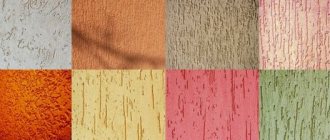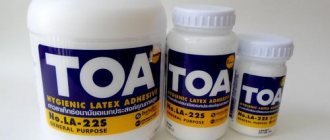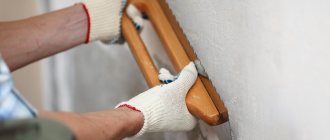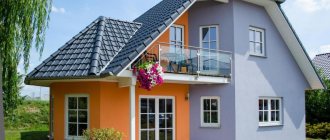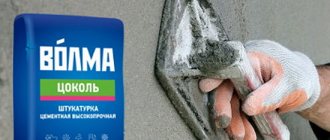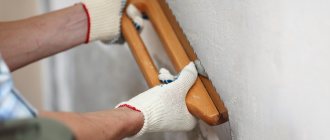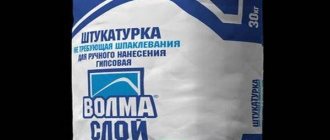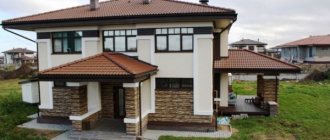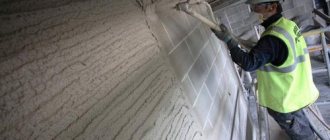Plastering the walls is required to obtain an ideal base for the installation of finishing materials. Many types of finishes, if installed on an uneven surface, will highlight flaws and the interior will suffer greatly as a result, and the level of adhesion may also be reduced. Unterputz facade plaster is suitable for use outside the building and in rooms with high humidity. A high-quality and reliable option for work. The article will describe the features of the material and the rules for working with it.
Description of Knauf Unterputz facade plaster
Knauf Unterputz plaster is produced in dry form, the base is cement, sand and a number of additional components that improve the properties of the composition. The description in the manufacturer's instructions states that the material is suitable for use indoors and outdoors. Can be applied with any type of tools designed for plastering work. They are used to treat facades and surfaces in rooms with high levels of humidity, if they are going to apply another type of finishing cladding afterwards.
Can be applied with any type of tools designed for plastering work.
Features and properties of cement heat-insulating plaster Khauf Grunband
Knauf is a company that has been present on the Russian market for a long time; over the years it has acquired a reputation as a quality brand that produces a variety of products for construction work. Taking into account the specifics of the Russian climate, the company has developed cement heat-insulating plaster Knauf Grundband. More details about the features of the tool and the rules for working with it will be discussed below.
Features of Knauf plaster
To obtain an insulating type of plaster mixture, it is necessary to use a porous filler in the composition. Knauf Grundband is distinguished by its moisture-repellent properties; cement, sand and various types of additional elements are used in its composition. Can be used both for work outside and inside the house. Suitable for facade cladding, walls, ceilings. They serve as a base, after which a decorative type of plaster is usually applied. Can be used for various materials, ceramic or silicate bricks, concrete, aerated concrete, expanded clay concrete, foam concrete base.
Compound
Knauf grunband differs from other types of plaster mixtures in that hydrophobic substances and expanded polystyrene in fine-grained form are added as constituent components. The first elements are a source of protection from moisture, the second are responsible for the thermal insulation of the surface, reducing the weight of the product so that the load on the surface is less.
Simply using these elements in plaster will not lead to warm plaster; it is necessary to use special elements for the binding function.
In Knauf warm plaster, all substances are distinguished by small fractions, which helps to obtain a coating of different density; the product can be applied manually and mechanically.
Advantages
Knauf Grundband has a number of positive properties, these advantages are the reason for the popularity of the product. The benefits of the product include:
- Reasonable price, it cannot be said that it is cheap, but considering the quality, the price is justified;
- You can use hand tools or specialized equipment on the surface;
- Vapor permeable property;
- Serves as a warming agent;
- Creates a protective layer against the negative effects of natural factors, protects the surface from moisture, so it can be used in rooms with high humidity - in the bathroom, in the kitchen;
- Eco-friendly product.
Area of use
This plaster mixture can be used for various purposes. To understand whether a composition can be used for a specific purpose, you should study the scope of application:
- For plastering walls and ceilings;
- Thermal insulation work of brick and stone masonry;
- As a plaster mixture for surfaces where other decorative materials will be applied.
The product can be used both outside and inside the building.
Properties
Knauf Grünband plaster is endowed with technical characteristics that help to obtain a high-quality result. The following properties can be distinguished:
- The thickness of the resulting layer is 10-30 mm;
- The maximum particle size of elements is one and a half millimeters;
- The density of the dried solution is 110 kg/m3;
- Drying time takes up to one week;
- Color grey;
- Thermal conductivity - 0.550 W/m sº.
Mixture consumption
Grundband consumption when creating a layer up to 15 mm thick will be 18 kilograms per square meter of surface. Consumption may be affected by the base material, application tool and number of layers. These factors should be taken into account when calculating the required amount of product.
Material storage
The product is produced in paper bags, the volume of which is 25 kilograms. The product has a shelf life of one year, and the storage location must be dry; it is advisable to place the bags on wooden pallets.
If the bag is torn, the mixture is poured into another completely, and it is used as quickly as possible.
Application of thermal insulation material
It is important to purchase products from trusted stores; before purchasing, they ask the seller for a certificate of conformity and quality. The maximum effect will be obtained if the application process is carried out correctly; you need to know under what conditions you can work, and the basic rules of the preparatory stage.
Conditions for work
Successful results are achieved when repair work is carried out under the right conditions. So it is necessary to apply the products when the ambient temperature is not lower than +5 degrees. It is necessary to take care to cover the area treated with the product from ultraviolet radiation and rain; protection will be needed during the drying period of the product. Also, other elements located near the plastered wall should be covered with a film to prevent moisture from getting on them.
Preparing the surface
In order for the plaster layer to be applied evenly and evenly, and good adhesion to be achieved, it is necessary to carry out preparatory work. This stage should not be neglected; the durability of the repair and its quality largely depend on it.
You should adhere to the operating instructions described below:
- The base must be clean, so it is washed with water to get rid of all types of contaminants and loose elements, all of which can interfere with reliable fixation. If the treatment will be carried out on a surface made of expanded clay concrete, ceramic bricks, pumice stone, which were laid not so long ago, then the surface should be made wet;
- If the base material is aerated concrete, then it must be primed; it is better to choose a primer solution of the same brand. This will reduce the consumption of funds;
- After that, you can proceed to applying the warmest plaster; you should cover at least half of the entire area at a time, then the layer is 5 millimeters or more;
- After applying the product, wait a couple of days until the solution hardens well;
- In the corner areas of the surface, special corners should be installed, they will protect the layer;
- In rounded zones, elastic transitions and seam areas, reinforcement is used and a reinforcing mesh is installed. It must be fixed in the solution while it is still wet, so that it is securely fixed, pressed with a spatula. It is necessary that the mixture completely covers the mesh. An overlap of ten centimeters is made.
Grunband plaster is a high-quality product that will help not only level the surface, but also insulate the room. It is not difficult to work with, so you can save money on the services of professionals by carrying out the repairs yourself. It is important not to forget to thoroughly prepare the surface before plastering the walls or ceiling.
Why Knauf
The Knauf brand has long conquered the construction market, and is considered among professionals and ordinary buyers as a company that produces high-quality materials for repair and construction. It stands out for its production of reliable and durable products. Unterputz Knauf plaster has improved protection against moisture, which is not a common feature for plaster mixtures, is easy to use and durable.
Unterputz Knauf plaster has improved protection against moisture.
Knauf Rotband
Knauf Rotband plaster is the most popular gypsum mixture among finishing craftsmen. It is applied to ceilings and walls, and to insulation (for example, polystyrene foam). The composition contains gypsum stone, and the list of components is supplemented by plasticizers and additives for elasticity.
The manufacturer allows plastering of walls in bathrooms and kitchens using Rotband. The scope of use of the mixture is limited to interior spaces. For a bag weighing 30 kg you will have to pay about 350 rubles.
Material characteristics:
- durable layer even with a large tent;
- safety for humans and pets;
- fire resistance;
- vapor permeability;
- resistance to microorganisms and fungi.
The result of application is a smooth surface of a white, pinkish or light gray shade. The maximum application layer in one go is from 5 to 50 mm on vertical surfaces, from 5 to 15 mm on the ceiling.
Distinctive features
Unterputz plaster is a popular mixture, the reason is the high-quality result obtained after use and drying. Experts emphasize the following features of the material:
- The mixture can only be stored in a dry room, moisture can lead to loss of working properties, shelf life is 6 months;
- It is important to properly mix the mixture with water before work, then all the declared characteristics will not be lost;
- It is optimal to make a 10 mm layer of plaster.
Unterputz plaster is a popular mixture, the reason is the high-quality result obtained after use and drying.
What is putty or how to perfectly level walls
Putty or putty is necessary for the same purpose as plaster.
Facade putty is used when working with external and internal walls (leveling surfaces for subsequent finishing work, decoration). This building material is also used to remove cracks and other surface imperfections.
The German company Knauf produces high-quality putty mixture and has long established itself in the building materials market.
Knauf Multifinish mixture has the following features:
- The mixture is produced according to technology at the plant;
- Easy to mix;
- Gives a smooth snow-white finish;
- Does not shrink or crack;
- Good adhesion to the surface;
- Easy application to the surface, thanks to polymer additives in the composition;
- Eco-friendly and safe material for humans;
- Suitable for both indoor and outdoor use;
- Frost-resistant and water-resistant material.
Characteristics
The quality of the result obtained depends on the technical characteristics of the compositions. This type of plasters is distinguished by the following properties, which are obtained due to the uniqueness of the product formulation:
- The thickness of the plaster layer can vary from 10 to 35 millimeters;
- The grain level does not exceed one and a half millimeters;
- Water-repellent property of at least 98%;
- The prepared solution should be used within 1.5-2 hours;
- Compressive strength – 4 MPa;
- Frost resistance of at least 50 cycles;
- The degree of vapor permeability is not less than 0.1 mg.
The prepared solution should be used within 1.5-2 hours.
Properties
Knauf Grünband plaster is endowed with technical characteristics that help to obtain a high-quality result. The following properties can be distinguished:
- The thickness of the resulting layer is 10-30 mm;
- The maximum particle size of elements is one and a half millimeters;
- The density of the dried solution is 110 kg/m3;
- Drying time takes up to one week;
- Color grey;
- Thermal conductivity - 0.550 W/m sº.
Knauf Grünband plaster is endowed with technical characteristics that help to obtain a high-quality result.
Advantages
The Unterputz plaster mixture is created using a complex recipe, and it is the constituent components that give it its positive characteristics. Among the advantages are the following:
- The universal property of the composition, the mixture can be used to close gaps and cracks on the base, gluing decorative polyurethane objects;
- Ease of use, even a beginner can handle it;
- Harmless to human health, contains no toxic substances. Can be used for children's rooms;
- Creation of additional thermal insulation;
- Vapor permeability is at a high level, maintaining an optimal microclimate in the room;
- Resistance to low temperatures;
- The service life is long, at least 25 years;
- Reasonable price.
Before purchasing, it is necessary to check the availability of a quality certificate by requesting it from the seller, so as not to receive a fake.
Vapor permeability is at a high level, maintaining an optimal microclimate in the room.
Application of thermal insulation material
It is important to purchase products from trusted stores; before purchasing, they ask the seller for a certificate of conformity and quality. The maximum effect will be obtained if the application process is carried out correctly; you need to know under what conditions you can work, and the basic rules of the preparatory stage.
The maximum effect will be obtained if the application process is performed correctly.
Application area
The main area of application is considered to be work on the facade in order to level and strengthen it. But internal work is allowed, the composition is safe. Selected for structures with high humidity: garages, basements, bathrooms, restrooms and others. Application tools can be either manual or mechanical.
The main area of application is considered to be work on the facade in order to level and strengthen it.
Cement-facade plaster Knauf Unterputz 25 kg - mixture consumption
The consumption stands out for its efficiency. The average consumption prescribed on the packaging implies applying a solution 10 millimeters thick, then approximately 17 kilograms will be required per square meter of area. The mixture is sold in bags of 25 kilograms; one package is enough to treat 1.47 square meters.
The consumption stands out for its efficiency.
Material storage
The product is produced in paper bags, the volume of which is 25 kilograms. The product has a shelf life of one year, and the storage location must be dry; it is advisable to place the bags on wooden pallets.
If the bag is torn, the mixture is poured into another completely, and it is used as quickly as possible.
The product has a shelf life of one year, and the storage location must be dry.
What you need to know before you start
Knauf Unterputz cement plaster can create a high-quality coating and cope with the task of leveling the surface, but it must be stored correctly before use:
- Choose a room where it is warm and dry. Resistance to moisture is characteristic only of the solution;
- Storage is permissible for up to 6 months, but during this period the packaging must not be damaged;
- The quality of the solution preparation also affects the result; follow all manufacturer’s instructions;
- The layer thickness should be kept at 10 mm; if it is necessary to increase the thickness, the layers are applied in stages, with a special mesh installed between them.
The quality of the solution preparation also affects the result; follow all manufacturer’s instructions.
Knauf Goldband
Goldband is a budget version of Knauf Rotband gypsum plaster, intended for use on brick and concrete surfaces.
The absence of additives in this mixture for additional particle gluing makes it impossible to use Goldband on ceilings. The maximum tent is 50 mm; it is not recommended to increase it even after the first layer has completely dried. If it is necessary to smooth out differences exceeding 5 cm, then it is recommended to first beat off the protruding fragments.
If the above conditions are met, you can save on gypsum plaster and buy Goldband instead of Rotband. The latest representative of the Knauf family can be purchased for 270 rubles. per bag of 30 kg. Consumption, packaging and drying time remain unchanged.
Professionals value the Knauf line of plasters for their versatility, and beginners note the ease of working with the compositions. An excellent result will be guaranteed to any master if he does not violate the manufacturer’s recommendations.
Tool for the job
Plastering also requires the presence of tools that will help distribute the composition evenly. The list of necessary tools is not long, it includes the following:
- Trowel for applying the solution to the surface;
- Spatulas and a rule to level the layer to the required thickness;
- Level to check the evenness of the base;
- A grater for smoothing the layer.
Plastering also requires the presence of tools that will help distribute the composition evenly.
How to prepare Unterputz Knauf solution
Pour the entire mixture from a 25-kilogram bag into 4.5-5 liters of water. To mix, use a construction mixer to obtain a homogeneous consistency. Then wait 5 minutes and stir again. If a too thick or thin condition is detected, then water or mixture is added accordingly.
It will not be possible to introduce new components during the workflow.
If plastering devices are used, then in the settings the water supply mode is set to 350 liters per hour, later the level changes.
To mix, use a construction mixer to obtain a homogeneous consistency.
How to choose application method
The choice of method for distributing the composition over the base is made according to the capabilities of the master. If the work is professional, then you can purchase plastering machines that will greatly simplify and speed up the process. For independent repairs, it is not advisable to spend money on these devices; you can use manual technology, which also gives high-quality results.
If the work is professional, then you can purchase plastering machines that will greatly simplify and speed up the process.
Advantages and disadvantages
Knauf gypsum plaster compositions contain mineral additives that significantly increase the service life of the coating. Due to the composition of such materials, coatings usually do not even have minor defects (depressions, roughness). Knauf plaster is very easy to use: finishing can be done even by people who have never had to deal with such work before. However, you will need to first understand its intricacies.
Other important advantages of such plaster compositions can be highlighted:
- Versatility. Knauf gypsum plaster can be used for plasterboard, cement, brick, and concrete bases. However, before using such material in any case, you will need to make sure that the surface is sufficiently durable. Using a plaster composition from this manufacturer, you can create a finishing layer, a rough screed. You can greatly simplify the construction process. The coating can be quite thick - about 5 cm.
- This plaster can be used before wallpapering. The base should be as level as possible. There should be no defects or textures. Knauf plaster composition allows you to achieve exactly this result.
However, such plasters also have some disadvantages:
- Quite a high price. However, this disadvantage is compensated by the remarkable quality of Knauf products.
- Shrinkage. Sometimes it has almost no effect on the coating, but in some cases it begins to crack and deform. Some consumers believe that the manufacturer is to blame for this, but it should be borne in mind that such defects often arise due to ignoring the rules for preparing and applying the material. Typically, the shrinkage of Knauf plaster is minimal. In some cases, external factors influence the condition of the coating: when using a plaster composition, a variety of nuances should be taken into account.
The main rules for plastering a wall
There are important operating rules that you need to know to successfully plaster the surface and obtain a long-lasting result. Professionals emphasize:
- The solution is applied in small areas; the layer should be leveled immediately, monitoring the thickness;
- When it is necessary to thicken the layer to 20-30 millimeters, then stage-by-stage layering is done, every 10 millimeters should be separated by a reinforcing mesh;
- Applying a new layer is possible only after the previous one has completely dried.
The solution is applied in small areas; the layer should be leveled immediately, monitoring the thickness.
Tips on step-by-step application of plasters on façade walls
The technology for distributing plaster mortars involves step-by-step work; the following steps should be performed one by one:
- Prepare the Adhesive composition, thoroughly wet the walls with water, apply the solution in a 5-mm layer, the surface will dry for 24 hours;
- Unterputz is applied to the dry surface and leveling is carried out according to the rule. They act quickly due to the quick-drying properties of the composition; after the layer has set, a grater is used;
- In corner parts it is better to install reinforcing mesh and apply a primer;
- The final leveling of the surface is done with a 10 mm layer of plaster;
- Finally, the wall is decorated with Diamond or other selected material.
The final leveling of the surface is done with a 10 mm layer of plaster.
Unterputz plaster mixture from Knauf gives high-quality results and is a durable material. If you follow the storage conditions, preparation of the solution and operating rules, you will be able to get the desired result yourself.
Leveling the surface
Plaster can only be laid on a previously prepared wall - that is, thoroughly cleaned of all previous facing materials, dust and dirt. The surface should be as clean and smooth as possible - but, however, in the case of plastering, minor defects, such as shallow cracks, can be left without repair.
We advise you to read how to restore the outer layer of facade plaster on our portal.
| In the warm season, the wall can be wetted during the preparation stage - this will remove dirt and dust faster. It should be borne in mind that the subsequent primer can only be applied to a dry surface! |
For a thick layer of plaster it is recommended to use reinforcing mesh
The next step is priming the wall with a special solution .
It is necessary to prime the wall in order to protect the house from excessive moisture. Knauf plaster itself is waterproof, but an additional level of protection never hurts.
We recommend reading what types of façade primers there are and finding answers to your questions.
If the plaster is supposed to be laid not on concrete or brick, but on a heat-insulating material, for example, polyurethane foam, there is no problem with this - you just need to use a fiberglass mesh to strengthen the structure.
| The mesh must be chosen so that after some time it does not crumble under the influence of moisture, acids and alkalis. Alkali-resistant meshes are more expensive, but you should not skimp on this point. |
